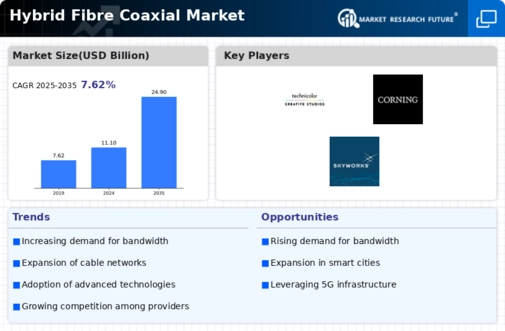Top Industry Leaders in the Hybrid Fibre Coaxial Market

Competitive Landscape of the Hybrid Fibre Coaxial (HFC) Market:
The hybrid fibre coaxial (HFC) market is experiencing a surge in demand, driven by the ever-growing need for high-speed and reliable broadband connectivity. HFC technology leverages the existing coaxial cable infrastructure while integrating fiber optics to deliver significantly faster data speeds compared to traditional cable alone. This makes it a cost-effective and scalable solution for internet service providers (ISPs) aiming to cater to the burgeoning bandwidth requirements of residential and business customers.
Some of the Hybrid Fibre Coaxial companies listed below:
- Huawei Technologies Co Ltd
- Nokia Networks
- Cisco System Inc
- Technicolor SA
- Corning Incorporated
- Cyan Corporation
- ZTE Corporation
- Infinera Corp
- Finisar Corporation
- Skyworks Solutions Inc
Strategies Adopted by key players:
- Product Innovation: Continuously enhancing HFC technology by incorporating the latest advancements in fiber optics and DOCSIS standards.
- Geographical Expansion: Targeting emerging markets with high internet penetration potential, particularly in Asia and Latin America.
- Strategic Partnerships: Collaborating with cable operators and ISPs to offer bundled HFC-based internet, TV, and voice services.
Factors for Market Share Analysis:
Analyzing market share in the HFC domain requires a comprehensive understanding of various factors, including:
- Technology Adoption: The extent to which different DOCSIS standards (e.g., 3.1) are being adopted by cable operators and ISPs.
- Regional Variations: Demand patterns and growth potential vary significantly across different geographical regions.
- Product Portfolio and Pricing: The breadth and competitiveness of a company's HFC equipment offerings and pricing strategies play a crucial role.
- Customer Base: The size and type of customer base targeted by a company, such as residential, business, or wholesale.
New and Emerging Companies:
Several new and emerging companies are making their mark on the HFC market, bringing fresh perspectives and innovative solutions. Some notable examples include:
- SCTE International: A global non-profit organization developing standards and best practices for the cable and telecommunications industry.
- CableLabs: A research and development consortium driving innovation in cable technologies, including HFC.
- Casa Systems: A vendor specializing in next-generation broadband access solutions, including cloud-native HFC platforms.
Latest Company Updates:
On Oct. 16, 2023, EnerSys (ENS), a global provider of stored energy solutions for cable broadband and telecommunications networks, announced its DOCSIS 3.1-enabled OEM module, the Alpha ADOM outdoor gateway, is recognized among the best in the industry by 2023. The Alpha ADOM outdoor gateway is an enabler for deploying 5G small cells across the cable broadband Hybrid Fiber-Coax (HFC) infrastructure, which provides high speed, low-latency backhaul and power across North America and around the globe.
On Oct. 13, 2023, CableLabs, a leading research & development lab for cables, announced that the latest specification, DOCSIS 4.0, evolves cable broadband to enhance the user experience as part of the industry's 10G initiative. CableLabs recently hosted two Interop. Labs events, convening suppliers and operators to share knowledge focused on bringing DOCSIS 4.0 technology to the field.
On Mar. 13, 2023, NBN Co Limited, Australia's wholesale broadband provider, announced its plan to introduce a new network termination device (NTD)/ or cable modem built around a new chipset sourced from Max Linear for its hybrid fibre coaxial (HFC) network. The company has changed the chipset within its HFC NTDs and will introduce a new HFC NTD by the end of 2023. However, this new alternative will have the same features and functionality as the current NTD.
On Feb. 03, 2023, Rogers Communications revealed its DOCSIS 4.0 plans and expects its HFC plant to stay ahead of market demand even after D4.0 tech becomes available. Rogers' DOCSIS 4.0 will be rolled on the Canadian operator's hybrid fiber/coax (HFC) plant. The company also feels confident that its existing HFC network capabilities will keep up with demand even after new DOCSIS 4.0 technologies become available.
